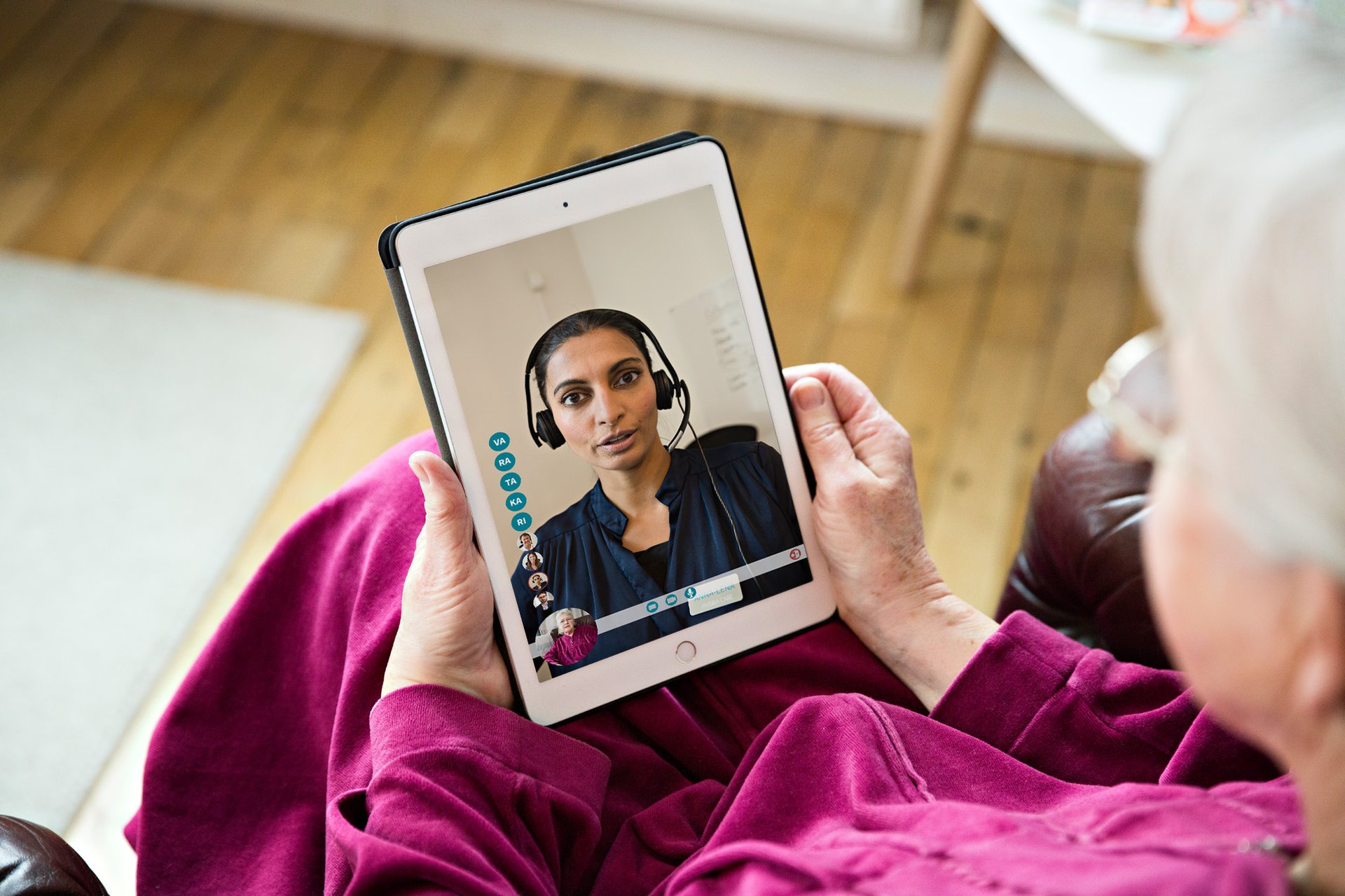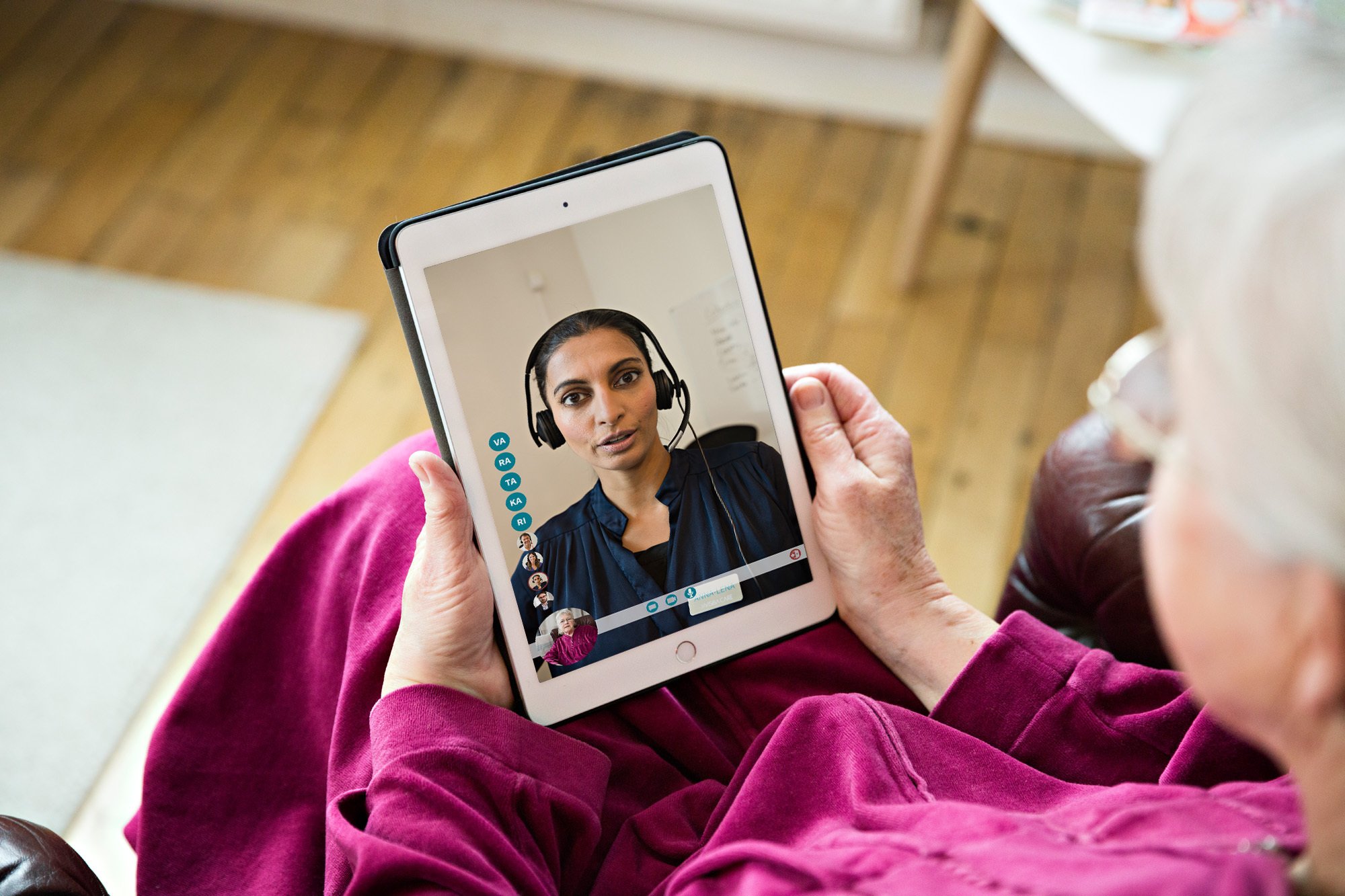
Guide
8 examples of how digital technology can support healthcare during the pandemic
In this guide, we highlight how some of our customers have adapted their working methods to provide accessible, safe care during the pandemic with the help of Visiba Care.
Introduction
We are amidst a second wave of the COVID-19 pandemic. The number of infections has increased dramatically in recent weeks, despite stricter restrictions. Healthcare is once again entering a phase of even greater pressure and several regions have gone into fight mode. In the meantime, the overall health state of the population is dropping dramatically as other conditions besides COVID-19 keep racing untreated: 4.35 million are on a waiting list for an appointment with secondary care and nearly 140,000 of them have been waiting over a year. In order for the population to get treatment in good time and in a safe manner, healthcare resources need to be used as efficiently as possible, and at the same time, they need to avoid physical contact to protect both patients and themselves from infection. All patient meetings that can be taken digitally should be taken digitally.
In this guide, we highlight how some of our customers in different areas of healthcare have adapted their working methods to provide accessible and safe care with the help of Visiba Care. Hopefully, these examples can also inspire others to discover new opportunities that facilitate work in this difficult time.
A flexible workplace enables the full capacity of all available resources
The fact that healthcare needs to make the best use of all its resources is undeniable. At the same time, a lot of healthcare professionals are constrained at their homes, despite having the capacity to work. Some may be in post-recovery quarantine or because a family member has symptoms. Others may belong to a risk group and need to avoid crowds. But online consultations are an exceptional opportunity to use these resources by giving them the tools to work from home in the digital patient pathways. All that is needed is to set up routines for remote work, ensuring that the staff has the right tools for digital meetings (computer, camera, and headset) and that there is a good connection with a VPN at home so that they can securely access EMRs and other important information.
ICU care – with the patient in focus
The situation in intensive care today is extremely pressured. Patients are seriously ill, sometimes anaesthetised. Relatives are not allowed to visit their loved ones to provide their support in a difficult situation. Doctors and nurses are working hard to take care of the patients, but at the same time, they have to update the relatives continuously – a sensitive and sometimes long procedure. The backlog of phone calls may be very long and during these calls, many questions need to be answered – often the same questions, asked by different individuals.
Having the opportunity to talk to patients’ relatives in multi-party conversations via video has been valuable to many patients and clinicians at ICU. Informing relatives and answering questions in a video call with several participants instead of contacting several people one by one saves an enormous amount of time for the healthcare professionals. In addition, families get the opportunity to see and support each other. The patient also experiences the value of meeting their loved ones via video. This kind of contact can make a huge difference in the recovery phase but can be equally important if recovery is not foreseen in a patient’s development and people are facing a farewell. Meeting someone via video is of course not the same as holding the hand of a loved one, but it is at least possible to see each other.

New conditions for integrated care
Digital transformation has shaped new conditions for integrated care, where social care, primary care and secondary care are working together to achieve the best possible health outcome for the population. An example is the integrated care operations (especially elderly housing), where, before the pandemic, healthcare professionals used to travel around between different elderly homes to meet patients. The way of working is unthinkable today, as physical meetings must be avoided to a great extent to ensure the patients’ safety. However, by introducing online consultations, the elderly can meet a doctor via video, together with a nurse on site. This not only reduces the risk of infection, but it also saves travel costs and above all, time – a critical aspect now that healthcare systems are under extreme pressure. With the digital channels available, the nurse and the doctor in charge at the collaborating health centres can communicate via video, while also having the possibility to brief the doctor by sending a ward round list in advance via secure messages.
A similar example of efficient collaboration comes from nurses in home care receiving support from GPs via video calls. This way, the patient avoids the risk of infection by going to a hospital or a GP surgery, while the doctor can still participate and consult remotely.
Another group in great need for effective coordination are the patients who need support and expertise from several specialists contributing to a person-centred coordinated care plan. For example, this may be a patient who is discharged from the hospital and transferred to housing services, a transfer that requires a thorough exchange of information and alignment between several parties. In a digital multi-party conversation, the stakeholders involved can easily participate without having to travel or putting their health to risk. It can be, for example, an interpreter, a relative, a representative from social services or employment services, depending on the patient’s situation.

Booking of physical visits – samples and vaccination
During the corona pandemic, ensuring that the population can easily access healthcare, whether that is for information, test samples etc, has been an additional challenge. The telephone queues are long and the patients who go out to actually visit a care facility have a difficult time receiving care and getting help with their condition. To relieve the staff and make it easier for the patients, a number of our customers have opened up the possibility of booking a physical appointment, such as for COVID-19 testing or the influenza vaccination, via a dedicated reception in the patient app. By enabling patients to book a physical appointment in the app, the healthcare providers not only increase control of the resources to receive a steady flow of patients but also ensure that the telephone lines are not blocked for patients seeking other kinds of care. As a further measure to prevent the spread of infection, one of the Swedish regions using Visiba Care have chosen to set up temporary vaccine receptions where everyone who has booked a vaccination appointment is referred to.
Additionally, digital channels enable healthcare providers to reach out to the residents themselves. One of our customers in Norway, a collaboration that includes six municipalities, decided that the elderly (65+) should be prioritised in getting the vaccine. As a next step, healthcare professionals are sending targeted text messages to this demographic, with a direct link for appointments in the virtual clinic, with some bookable times earmarked just for them.
Asynchronous messages and automated history collection for non-urgent primary care cases
Even though healthcare is under high pressure, there is naturally a list of other conditions, that are not urgent but must be tended to. One way to deal with them effectively is to automate the medical records and to guide non-acute patient cases to an asynchronous messaging channel with a nurse. Patients then get the opportunity to disclose their condition and medical history in an automated chat when they are seeking care. A compilation of this information is then forwarded to a nurse via a secure message. If necessary, the nurse can address the patient with follow-up questions in the same channel and assess whether to manage the case independently or refer the patient on to a clinician or another care resource.
This way gives healthcare providers the tools to ensure optimal use of their resources, while at the same time, minimising administration time. This in turn leads to a significant increase of attended patient cases.
Asynchronous messages in specialist care – increased patient security and care efficiency
Many patients in secondary care have an increased need to easily get in touch with their healthcare provider for non-acute issues. It can be anything from post-operative concerns or thoughts about rehabilitation. The team of healthcare professionals together with the patient can decide to open up an asynchronous message channel for questions and concerns, which results in reduced incoming phone calls to the reception as well as an increased sense of security for the patients.
There is also the possibility of opening a messaging channel for patients’ questions and staff the channel with nurses or receptionists. An open channel of this format has been shown to greatly reduce the number of telephone calls to the reception. This type of case can be handled quickly and is not addressed to any clinician, which means that the nurses can work efficiently. Working this way, some clinics have saved up to 50% of the time spent managing incoming issues.
Digital channels for mental health treatment
Covid-19 has deeply affected many patient groups in our society, and those suffering from mental health issues should not be overlooked. At the same time, the special isolation circumstances of the pandemic entail by default an increased risk of impaired mental health and anxiety, depression, or PTSD. To ensure that those affected receive the help they need, several of our customers have moved over their treatment plans and regular follow-ups to online consultations. In eating disorder treatment, for example, patients have the opportunity to return to regular group dinners with all the participants joining online multiparty calls. In CBT, the entire treatment plan has been moved to digital channels with the help of video calls, rating scales and message conversations to follow up on tasks and exercises.

Rehabilitation in the impact of COVID-19
The challenges that arose with COVID-19 will unfortunately not vanish after the pandemic is over. Healthcare will require an enormous number of resources in the form of rehabilitation for everyone affected during the pandemic – in one way or the other. Already today, we have seen the burden in rehabilitation increase in many parts of the country. Working with digital pathways, rehab centres have the opportunity to offer group training and multi-party conversations between patients and physiotherapists remotely – meetings that would have otherwise been extremely difficult or even impossible.
—
In the guide, we have highlighted a few examples of how our customers have digitally transformed patient pathways to minimise the risk of infection and continue providing their care services during the COVID-19 pandemic. Feel free to contact us if you want to bounce your ideas or get strategic inspiration on how Visiba Care and Red Robin can create value for your business.